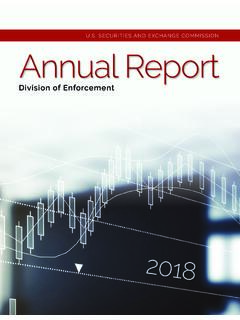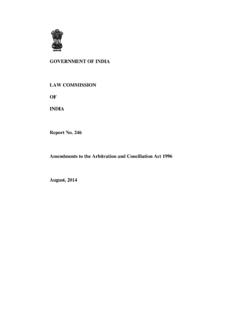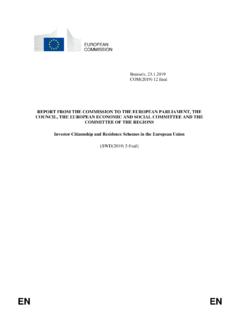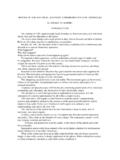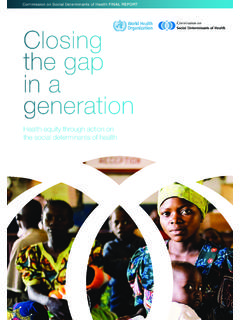Transcription of Distributed Energy Resources - ferc.gov
1 Distributed Energy Resources Technical Considerations for the Bulk Power System staff report Docket No. AD18-10-000. February 2018. The opinions and views expressed in this staff report do not necessarily represent those of the Federal Energy Regulatory Commission, its Chairman, or individual Commissioners, and are not binding on the Commission. Docket No. AD18-10-000. Table of Contents Executive Summary .. 3. 1. Background .. 5. 2. Defining DERs .. 7. 3. Bulk Power System Reliability Considerations for 10. Potential DER Reliability Issues.
2 10. The Lack of DER Data and the Implications for the Bulk Power System .. 11. Coordination between the Bulk Power System and Distribution System .. 15. Potential Reliability Benefits of DERs .. 18. Communication and Technological Capabilities of DERs .. 18. Developments at the Transmission-Distribution Interface: The DSO Model .. 19. 4. Technical Studies and Results .. 21. Role of Distribution Models in Planning Studies (Distribution Modeling). 21. Study Purpose .. 22. Assumptions and Data .. 23. Methodology .. 24. Results .. 25. DERs and System Performance Following Generator Outages (Power Flow Study).
3 27. Study Purpose .. 27. Assumptions and Data .. 27. Methodology .. 30. Results .. 31. Impact of DERs on Dispatch (Production Cost Modeling) .. 35. Study Purpose .. 35. Assumptions and Data .. 35. Methodology .. 36. Results .. 37. 1|Page Docket No. AD18-10-000. Ancillary Services Provided by Energy Storage (Distribution Modeling) 38. Study Purpose .. 38. Assumptions and Data .. 39. Methodology .. 39. Results .. 40. Assessing the Benefit of Smart Inverters to Reliability (Distribution Modeling) .. 43. Study Purpose .. 43. Assumptions and Data.
4 43. Methodology .. 43. Results .. 44. 5. Conclusions .. 46. 2|Page Docket No. AD18-10-000. Executive Summary Traditionally, Distributed Energy Resources (DERs) referred to small, geographically dispersed generation Resources , such as solar or combined heat and power (CHP), installed and operated on the distribution system at voltage levels below the typical bulk power system levels of 100kV. In recent years, DER installations have increased significantly in some regions of the United States due in part to technology advances and state Energy policies.
5 This report considers how the increasing penetration and integration of DERs in specific regions may affect bulk power system reliability. This report focuses primarily on the technical considerations for DERs as they are currently operated, and does not necessarily address how DERs may participate in the markets operated by the regional transmission organizations and independent system operators (RTOs/ISOs). To this end, FERC staff performed a series of technical assessments using industry power system models and commercially available power system simulation software to identify the potential reliability issues and likely benefits to the bulk power system resulting from an increased penetration of DERs.
6 staff 's work identified, at a high level, several key topics that are addressed in this report and can be summarized as follows: The impact of the current common industry modeling practice of netting DERs with load, 1 which may mask the effects of DER operation;. DER capabilities for voltage and frequency ride through during contingencies;. The potential for improved customer-level voltages due to the unloading of the bulk power system associated with the location of DERs at or near customer loads;. Potential effects on system-wide transmission line flows and generation dispatch due to changing load patterns; and The sensitivity of voltage or power needs to different types of DER.
7 Applications ( , the provision of Energy , capacity, or ancillary services). Overall, the results of this analysis suggest that increasing DER capacity, if not properly accounted for, could cause reliability concerns for the bulk power system. 2. Further industry discussion is needed to improve and refine the data that is available for 1. Such as described in NERC Reliability Standard MOD-032-1 Data for Power System Modeling and Analysis, requiring Load Serving Entities to aggregate Demand at each bus. 2. DER capacity modeling was based on current trends for technology types, operational capabilities, and deployment distributions.
8 3|Page Docket No. AD18-10-000. DERs that will be incorporated into planning and operating models. Collecting and using the most current and accurate data is key to getting a complete picture of how DERs affect the bulk power system. In addition, further discussion and study is needed regarding other issues, such as sensitivities with higher DER penetration levels, changes in siting patterns, and potential impacts to the system's response to events, disruptions and outages, including frequency events. Further exploration in these areas will help the Commission to track and assess the impact of changing conditions on the bulk power system to identify emerging trends and address potential future reliability challenges.
9 4|Page Docket No. AD18-10-000. 1. Background DER adoption is growing in the United States, due in part to state, local, and federal policies. In 2016, DERs accounted for about two percent of the installed generation capacity in the United States, but Distributed solar photovoltaic (PV). installations alone represented over 12 percent of new capacity additions. 3 Certain regions have experienced disproportionately greater growth in the installed capacity of DERs. For example, California currently has over 7,000 MW of installed DER capacity 4.
10 As shown in Figure 1, and has set a target to integrate 12,000 MW 5 of DERs by 2020. 6. 3. Twenty-four gigawatts of new utility-scale generating capacity and gigawatts of new Distributed small scale photovoltaic were added in 2016 according to the Energy Information Administration. See Renewable Generation Capacity Expected to Account for Most 2016 Capacity Additions, the Energy Information Administration, (January 2017), available at and Electric Power Monthly Chapter 6: Capacity, the Energy Information Administration, (February 2016 with data for December 2016), available at 4.










